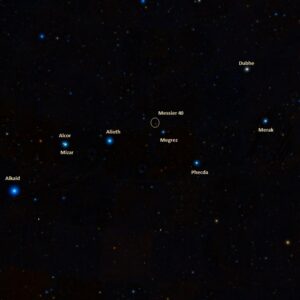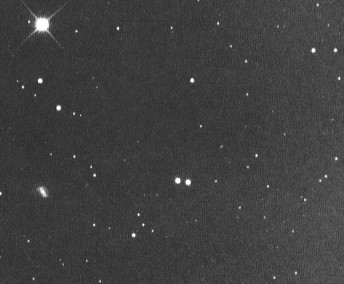Messier 40, M40, also known as Winnecke 4, is a double star located in the constellation Ursa Major, the Great Bear. It is one of the few Messier objects that are not deep sky objects, but were catalogued by mistake. It was not listed in the New General Catalogue (NGC).
| Description | |
| Visible From Pacific Northwest | November to May |
| Best Time To Observe | February and March |
| Minimum Size Of Viewing Device | 10×50 binoculars |
| Object Type | Double Star |
| Designations | Messier 40, M40, Winnecke 4, WNC 4, BD+56 1372, CCDM 12223+5805, WDS J12222+5805AB, HD 238107 and HD 238108, SAO 28353 and SAO 28355 |
| Right Ascension | 12h 22m 12.5s |
| Declination | +58°4’59” |
| Constellation | Ursa Major |
| Apparent magnitude | +9.65, +10.10 |
| Distance From Earth | 510 light years |
History
Messier 40 was discovered by the German astronomer Friedrich August Theodor Winnecke in 1863. Winnecke included it in the Winnecke Catalogue of Double Stars as the fourth entry, WNC 4. When Winnecke discovered the double star, the angular separation between the two components was measured as 49.2 arc seconds.
John Mallas, an American amateur astronomer, was able to identify Winnecke 4 as Messier’s 40th catalogue entry around 1965. In 1966, the separation between the stars was determined as 51.7 arc seconds. By 1991, it increased to 52.8 arc seconds.
Locating M40 In The Sky
Messier 40 is easy to find as it lies right next to Megrez, one of the bright stars that form the Big Dipper asterism in Ursa Major. Megrez is the star that connects the handle of the Big Dipper to the cup, or the star at the base of the Great Bear‘s tail. M40 is located about 1.5 degrees northeast of Megrez and 17 arc minutes northeast of 70 Ursae Majoris, an orange giant star with a visual magnitude of 5.54.

Viewing M40
Winnecke 4 can be seen in 10×50 binoculars, but is better viewed in 20×80 binoculars or small telescopes. Small and medium-sized telescopes will show a pair of stars, one orange-yellow and the other white in colour.
Photographing M40
There are a plethora of ways to photograph Messier 40, but it is crucial to make sure to utilize the proper filters. Most of the resources available will show use of luminance, red, green, and blue filters for several minutes each before integrating the photos. Autoguiding will be required and it is recommended to utilize a telescope that has the equivalent aperture of 6 inches or greater.
Sources And Further Reading
Descriptions of all of Messier Objects can be found here.
https://freestarcharts.com/messier-40
http://www.perseus.gr/Astro-DSO-M40.htm

Be the first to comment on "Messier 40"